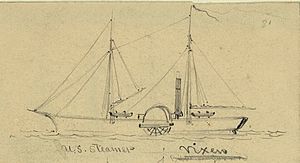USS Vixen (1846) facts for kids

USS Vixen
|
|
Quick facts for kids History |
|
|---|---|
| Name | USS Vixen |
| Builder | Brown and Bell, New York City |
| Acquired | by purchase, May 1846 |
| Decommissioned | 1853 |
| Fate | Sold, 1855 |
| General characteristics | |
| Type | Gunboat |
| Displacement | 240 long tons (244 t) |
| Length | 118 ft (36 m) |
| Beam | 22 ft 6 in (6.86 m) |
| Draft | 7 ft (2.1 m) |
| Propulsion | Steam engine |
| Speed | 7.5 knots (13.9 km/h; 8.6 mph) |
| Complement | 55 officers and enlisted |
| Armament |
|
The USS Vixen was a special kind of ship called a steamboat that served in the United States Navy. It was active during a big conflict called the Mexican–American War. This ship was actually built for the government of Mexico by a company named Brown and Bell in New York City. But, right when the Mexican-American War began in May 1846, the U.S. Navy bought the Vixen to use in their fleet.
Contents
Vixen's Role in the Mexican-American War
Immediately after the U.S. Navy bought her, the Vixen was sent to the Gulf Coast of Mexico. She joined a group of ships called a blockade squadron, led by Commodore David Conner. A blockade means stopping ships from entering or leaving a port. The Vixen helped by patrolling the area and gathering information. This helped the Army and Navy prepare for movements further inland.
First Battles and Victories
Under the command of Joshua R. Sands, the Vixen first saw action on October 16, 1846. She tried to help capture Alvarado, an important Mexican port. The Vixen towed two smaller ships, the Bonita and Reefer. However, the American fleet could not cross a sandbar near the port, so they had to stop the attack.
After this, the squadron moved south to try and separate the Yucatán Peninsula from the rest of Mexico. To do this, they needed to capture Frontera, a port at the mouth of the Tabasco River. Then, they aimed to take the city of Tabasco, which was further up the river.
On October 23, the Vixen and other ships got into position near Frontera. Commodore Matthew C. Perry took command of the Vixen. With the schooners Bonita and USRC Forward in tow, the Vixen quickly crossed the sandbar. They captured the Mexican ships defending the port. The Vixen and Perry then sailed up the Tabasco River on October 24 and 25. They finally secured Tabasco on October 26 after the Vixen fired three shots at the city.
Capturing Key Mexican Ports
After successfully completing the Yucatán campaign, the Vixen went back to blockading the coast. She later helped capture Laguna on September 20. The Vixen also assisted in taking Tampico on November 14.
One of her most important roles was covering the landing of troops at Vera Cruz on March 9, 1847. Vera Cruz was the main military target for the fleet. Mexican defenders did not agree to peace, so the American squadron attacked the city on March 23. Two days later, the Spitfire and Vixen made a brave and impressive attack. They got very close to the defensive forts on shore. Vera Cruz finally surrendered completely on March 28. This big victory allowed General Winfield Scott to march on Mexico City using the shortest land route. It was a very important moment in the Mexican War.
After the War
The Vixen continued to help with clean-up operations until the war ended. The Treaty of Guadalupe Hidalgo was officially agreed upon on May 30, 1848. This treaty officially ended the Mexican-American War. After the war, the Vixen joined the Home Squadron, a group of ships that protected the U.S. coast.
In 1850, the ship underwent repairs at the Washington Navy Yard. In 1853, the Vixen was temporarily taken out of service, or decommissioned, at Pensacola, Florida. This happened because many sailors on board got sick with yellow fever, a serious illness. She then had more repairs at the Brooklyn Navy Yard in 1854.
The Vixen was sold in 1855, ending her service with the U.S. Navy.

